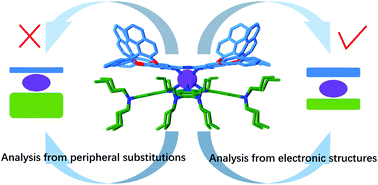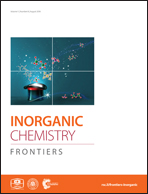Heteroleptic chiral bis(phthalocyaninato) terbium double-decker single-ion magnets†
Abstract
For the purpose of engineering magnetic anisotropy, chiral binaphthyl substituents with slight electron-withdrawing ability and dibutylamino substituents with intense electron-donating nature are incoporated onto the periphery of each phthalocyanine ligand in the bis(phthalocyaninato) terbium double-decker compound, resulting in the chiral heteroleptic bis(phthalocyaninato) terbium complex (R)/(S)-[Pc(OBNP)4]Tb{Pc[N(C4H9)2]8} (R/S-1) {Pc(OBNP)4 = {tetrakis(dinaphtho[1,2-e:1′,2′-g]-1,4-dioxocine)[2,3-b;2′,3′-k;2′′,3′′-t;2′′′,3′′′-c′]phthalocyanine}; Pc[N(C4H9)2]8 = [2,3,9,10,16,17,23,24-octakis(dibutylamino)phthalocyanine]}. Magnetic studies reveal the typical single-ion magnet (SIM) nature of this chiral bis(phthalocyaninato) terbium double-decker with spin reversal energy barrier of 638 K. A butterfly-shaped magnetic hysteresis loop was observed at even 25 K for R-1 under the sweep rate of 500 Oe s−1. The performance of this SIM is well rationalized on the basis of theoretical analysis of the electrostatic potential according to calculations using the density functional theory method.



 Please wait while we load your content...
Please wait while we load your content...